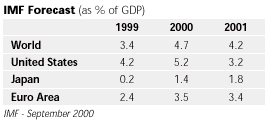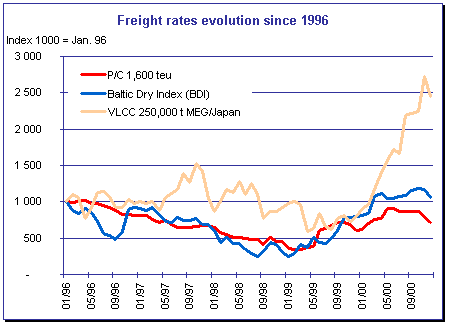|
1. An extremely significant growth, of almost 60%,
in the level of newbuilding compared to 1999. More than 46 million gt were
ordered in 2000 against about 29 million gt in 1999. This increased demand
was for all types of vessels and was particularly evident in the tanker,
container and dry bulk (Handysize / HandyMax) sectors.
2. The saturation of newbuilding capacity. Growth
in demand resulted in the global orderbook reaching historical high levels,
advancing about 25 % and passing the 58.9 million gt figure at the end of
1999 to reach 71.1 million gt by the end of 2000. The orderbook by the
middle of 2000 was full with deliveries through to mid 2003. The shipyards
became more selective, refusing to quote for later deliveries and selling
their remaining open berths at more expensive prices.
3. The rise in newbuilding prices for most types
of vessels for the first time since the beginning of the nineties was about
10 % to 25 %. This price increase however was not universal and depended on
both the size and type of vessel as well as the amount of competition
between the shipyards. The price rises were most significant for tankers and
containerships and less pronounced for bulk carriers.
4. The exceptional performance of Korean
shipbuilders who collectively took orders for about 21 million gt, almost
half of the total orders placed world-wide in 2000. This brought the Korean
orderbook up to 30 millions gt. (a figure in excess of the entire global
orderbook of 1989). Japan also achieved significant results, taking orders
for almost 14 million gt, keeping their orderbook at about 18
million gt, but its market share decreased.
5. The conflict between the European Union
shipbuilders and their Korean counterparts took on a new dimension as the
Association of West European Shipbuilders decided to bring the dispute to
the highest political level of the European Union, which in turn threatens
to bring the dispute before the World Trade Organisation.
The year 2000 was characterised in economic terms as an
exceptional year. Growth on a global basis was much stronger than 1999 and
was spread over all three of the world's main economic zones.
The expansion of world trade increased from 5 % in 1999
to 10 % in 2000 against an average growth rate during the nineties of 6
%-6.5 %.

Freight rates in the three main marine transport sectors
experienced substantial increases, tripling for tankers in the case of crude
oil trades, with a strong increase in rates for refined petroleum products,
dry bulk cargoes and container shipping not far behind.
Freight rates in the petroleum sector were powered by not
only the increased demand for crude oil, but also by the emergence of
restrictive chartering policies in regard to vessel age instituted by oil
companies in the aftermath of the 'Erika' disaster. Tankers chartered by
oil majors must meet ever stricter quality requirements. Over-aged tankers
are no longer considered by oil majors.

|